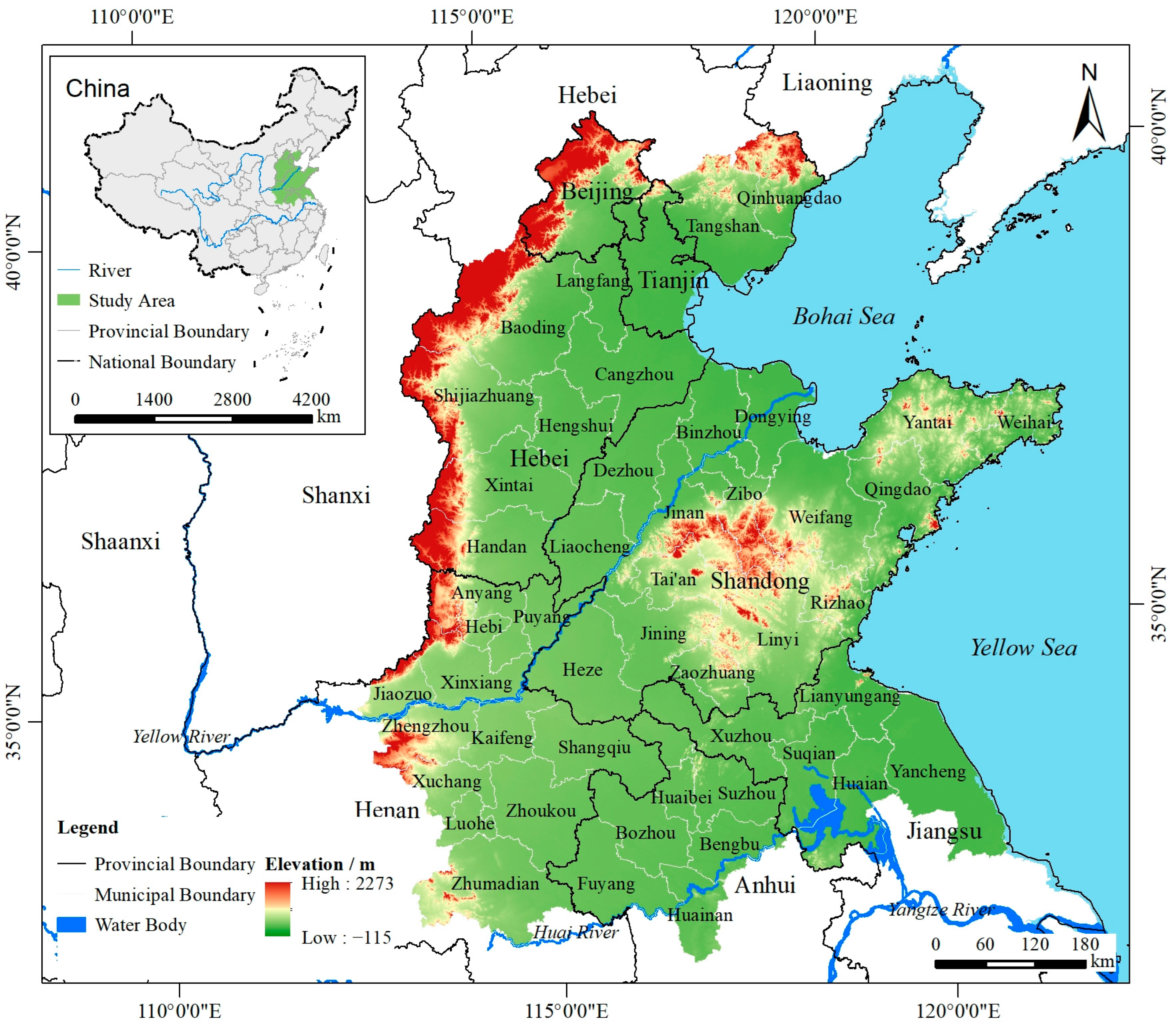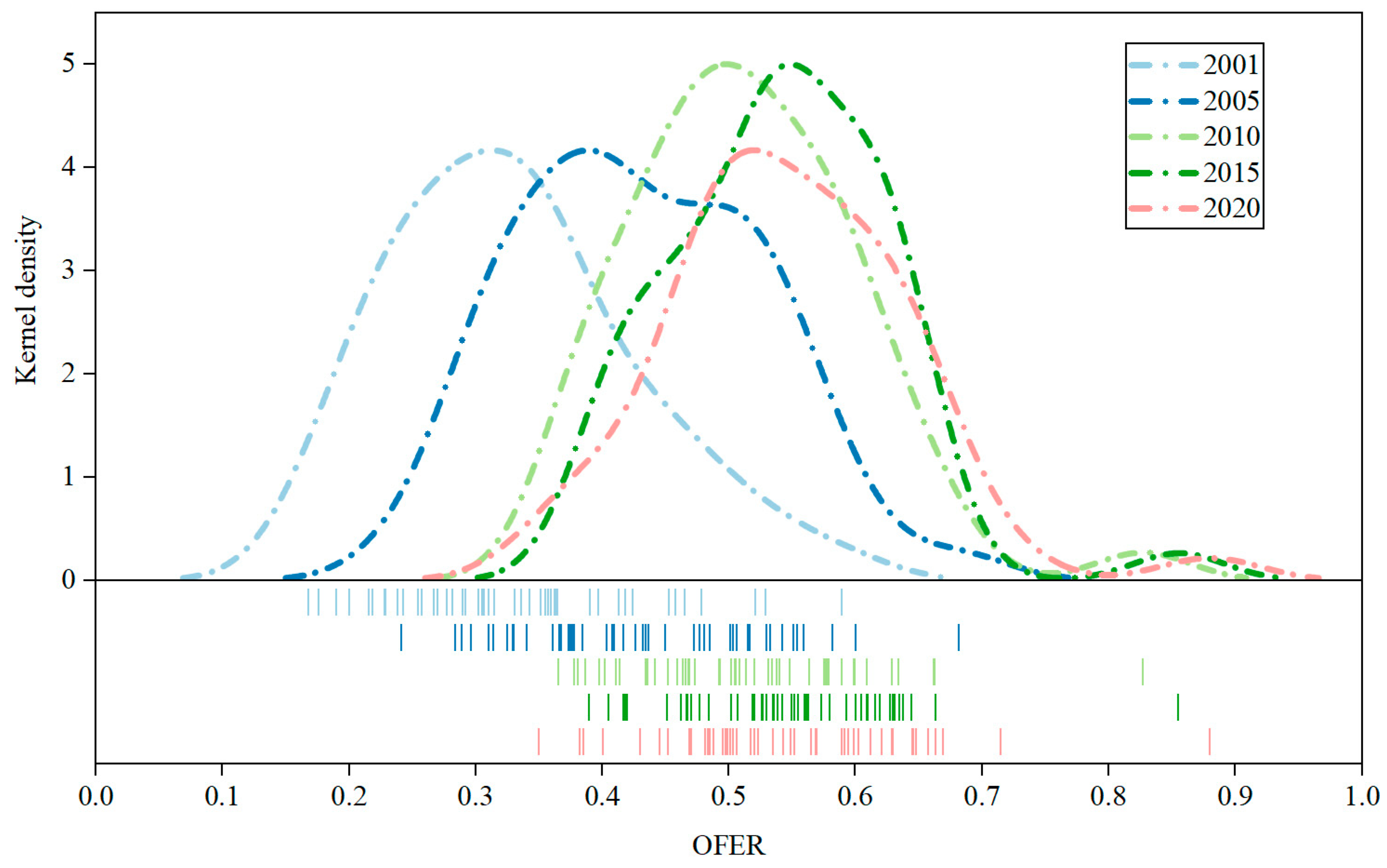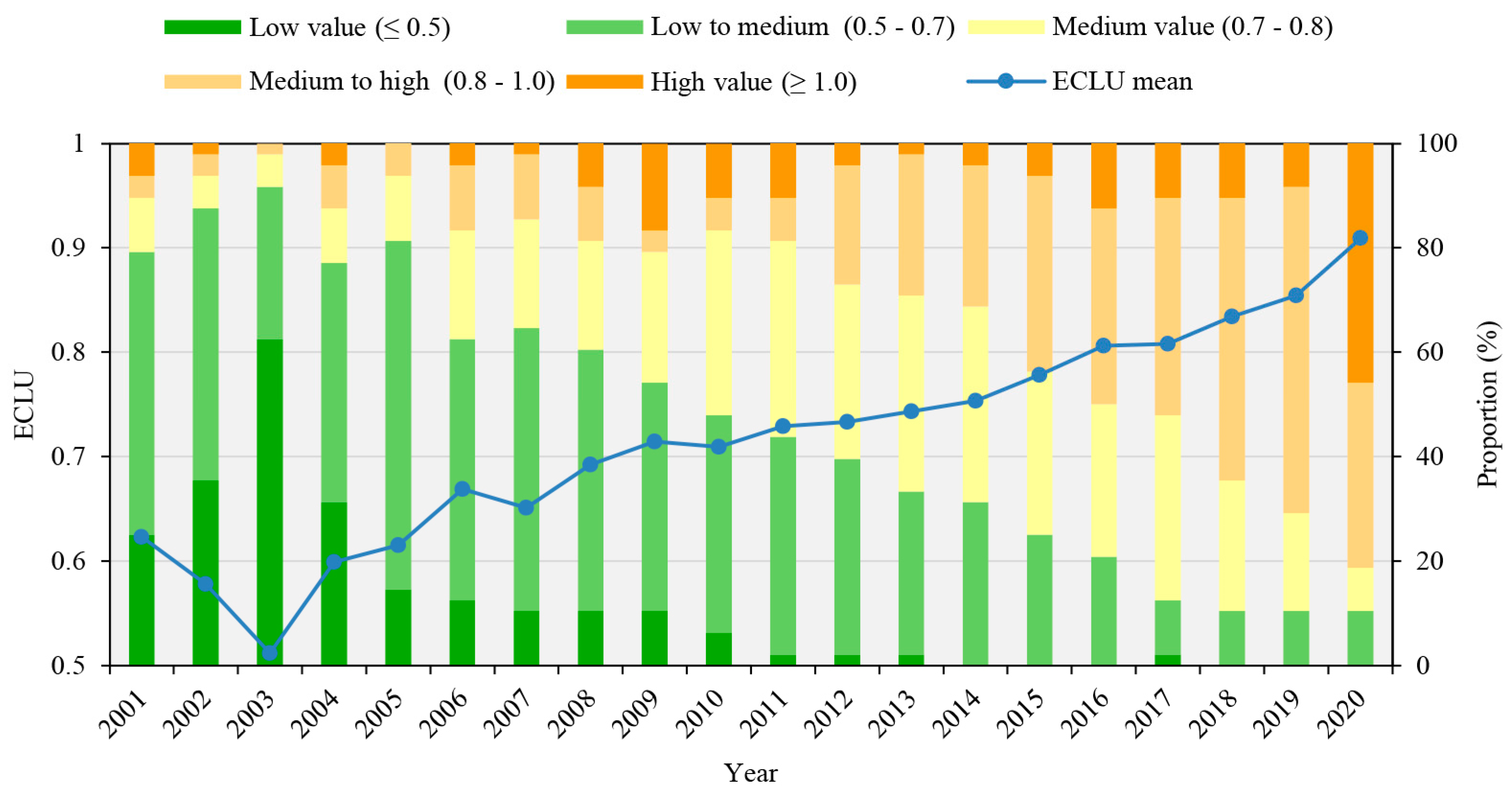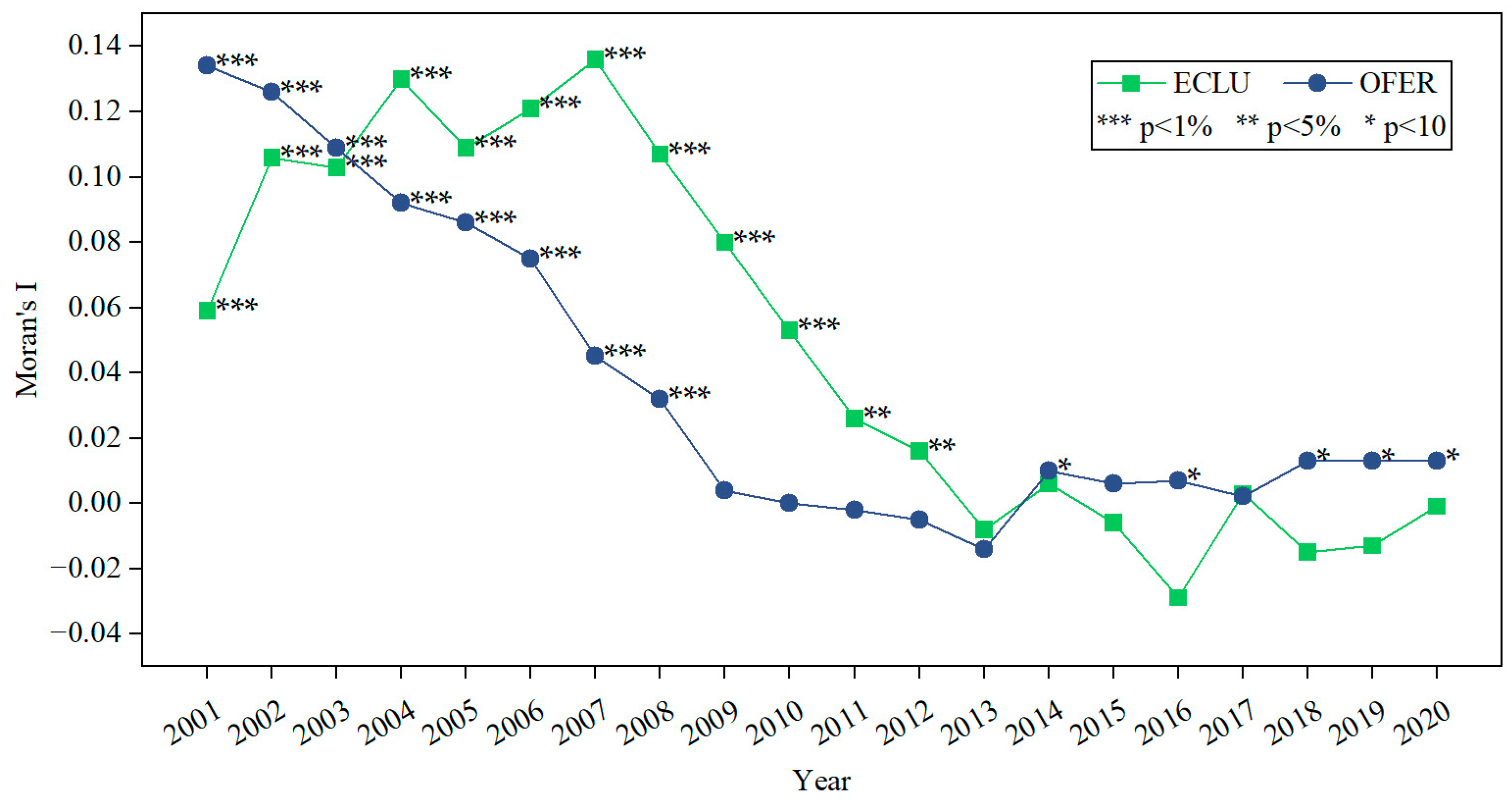Effects of Off-Farm Employment on the Eco-Efficiency of Cultivated Land Use: Evidence from the North China Plain
Abstract
:1. Introduction
2. Mechanism Analysis and Hypotheses
2.1. The U-Shaped Impact of Off-Farm Employment on the ECLU
2.2. Spatial Spillover Effects of Off-Farm Employment on the ECLU
3. Materials and Methods
3.1. Study Area
3.2. Super-Efficiency EBM Model
3.3. Spatial Econometric Model
3.3.1. Global Spatial Autocorrelation Analysis
3.3.2. Model Specification
3.4. Variable Definitions and Descriptions
3.4.1. Explained Variable
3.4.2. Core Explanatory Variable
3.4.3. Control Variables
3.5. Data Source
4. Empirical Results
4.1. Probability Distribution of Off-Farm Employment
4.2. Spatial–Temporal Pattern of the ECLU
4.3. Spatial Effect of Off-Farm Employment on the ECLU
4.3.1. Spatial Autocorrelation Test
4.3.2. Model Identification
4.3.3. Model Estimation
4.3.4. Spatial Spillover Effect
4.4. Robustness Test
5. Discussion
5.1. Major Findings
5.2. Policy Implications
5.3. Limitations and Outlooks
6. Conclusions
Author Contributions
Funding
Data Availability Statement
Acknowledgments
Conflicts of Interest
Appendix A
| Variable | Direct | Indirect | Total |
|---|---|---|---|
| OFER | −0.563 ** | −7.784 *** | −8.347 *** |
| (0.234) | (3.000) | (2.986) | |
| OFER2 | 0.691 *** | 10.326 *** | 11.017 *** |
| (0.231) | (3.438) | (3.454) | |
| CSA | 0.152 *** | 0.146 | 0.297 |
| (0.021) | (0.421) | (0.432) | |
| MCI | −0.004 | −1.109 *** | −1.113 *** |
| (0.018) | (0.391) | (0.399) | |
| EIR | 0.070 *** | −0.331 | −0.261 |
| (0.024) | (0.519) | (0.536) | |
| AML | −0.004 *** | −0.007 | −0.010 |
| (0.001) | (0.015) | (0.016) | |
| RDI | −0.022 | −0.749 | −0.771 |
| (0.029) | (0.621) | (0.623) | |
| FSA | −0.177 *** | 0.496 | 0.319 |
| (0.042) | (0.991) | (1.007) |
References
- Qin, H.; Liao, T.F. Labor Out-Migration and Agricultural Change in Rural China: A Systematic Review and Meta-Analysis. J. Rural. Stud. 2016, 47, 533–541. [Google Scholar] [CrossRef]
- Dzanku, F.M. The Gender and Geography of Rural Off-Farm Employment and Input Intensification in Five Sub-Saharan African Countries. Food Policy 2018, 75, 37–51. [Google Scholar] [CrossRef]
- Tabe-Ojong, M.P.; Molua, E.L.; Nanfouet, M.A.; Mkong, C.J.; Kiven, V.; Ntegang, V.A. Oil Palm Production, Income Gains, and off-Farm Employment among Independent Producers in Cameroon. Ecol. Econ. 2023, 208, 107817. [Google Scholar] [CrossRef]
- Larson, D.; Mundlak, Y. On the Intersectoral Migration of Agricultural Labor. Econ. Dev. Cult. Change 1997, 45, 295–319. [Google Scholar] [CrossRef]
- Mathenge, M.K.; Tschirley, D.L. Off-Farm Labor Market Decisions and Agricultural Shocks among Rural Households in Kenya. Agric. Econ. 2015, 46, 603–616. [Google Scholar] [CrossRef]
- Van den Broeck, G.; Kilic, T. Dynamics of Off-Farm Employment in Sub-Saharan Africa: A Gender Perspective. World Dev. 2019, 119, 81–99. [Google Scholar] [CrossRef]
- Jiménez-Moreno, M.; Lazos-Chavero, E.; Balvanera, P. (Dis)Connections between Youth Migration and Food Security in a Rural Community of the Sierra de Santa Marta, Veracruz, Mexico. J. Rural. Stud. 2023, 100, 103028. [Google Scholar] [CrossRef]
- Ghimire, T.; Harou, A.P.; Balasubramanya, S. Migration, Gender Labor Division and Food Insecurity in Tajikistan. Food Policy 2023, 116, 102438. [Google Scholar] [CrossRef]
- Yang, J.; Wan, Q.; Bi, W. Off-Farm Employment and Grain Production Change: New Evidence from China. China Econ. Rev. 2020, 63, 101519. [Google Scholar] [CrossRef]
- Ge, D.; Long, H.; Qiao, W.; Wang, Z.; Sun, D.; Yang, R. Effects of Rural–Urban Migration on Agricultural Transformation: A Case of Yucheng City, China. J. Rural. Stud. 2020, 76, 85–95. [Google Scholar] [CrossRef]
- Alvarez-Cuadrado, F.; Poschke, M. Structural Change out of Agriculture: Labor Push versus Labor Pull. Am. Econ. J. Macroecon. 2011, 3, 127–158. [Google Scholar] [CrossRef]
- Dzanku, F.M.; Tsikata, D. Implications of Socioeconomic Change for Agrarian Land and Labour Relations in Rural Ghana. J. Rural. Stud. 2022, 94, 385–398. [Google Scholar] [CrossRef]
- Xu, D.; Deng, X.; Guo, S.; Liu, S. Labor Migration and Farmland Abandonment in Rural China: Empirical Results and Policy Implications. J. Environ. Manag. 2019, 232, 738–750. [Google Scholar] [CrossRef]
- Macours, K. Agricultural Labor Adjustments in Transition Countries: The Role of Migration and Impact on Poverty. Rev. Agric. Econ. 2005, 27, 405–411. [Google Scholar] [CrossRef]
- Das, P.; Saha, J.; Chouhan, P. Effects of Labor Out-Migration on Socio-Economic Set-up at the Place of Origin: Evidence from Rural India. Child. Youth Serv. Rev. 2020, 119, 105512. [Google Scholar] [CrossRef]
- Schaltegger, S.; Sturm, A. Öologische Rationalität (German/in English: Environmental Rationality). Die. Unternehmung. 1990, 4, 117–131. [Google Scholar]
- Caiado, R.G.G.; de Freitas Dias, R.; Mattos, L.V.; Quelhas, O.L.G.; Leal Filho, W. Towards Sustainable Development through the Perspective of Eco-Efficiency-A Systematic Literature Review. J. Clean. Prod. 2017, 165, 890–904. [Google Scholar] [CrossRef]
- Xie, H.; Chen, Q.; Wang, W.; He, Y. Analyzing the Green Efficiency of Arable Land Use in China. Technol. Forecast. Soc. Change 2018, 133, 15–28. [Google Scholar] [CrossRef]
- Yang, B.; Wang, Z.; Zou, L.; Zou, L.; Zhang, H. Exploring the Eco-Efficiency of Cultivated Land Utilization and Its Influencing Factors in China’s Yangtze River Economic Belt, 2001–2018. J. Environ. Manag. 2021, 294, 112939. [Google Scholar] [CrossRef]
- Yin, Y.; Hou, X.; Liu, J.; Zhou, X.; Zhang, D. Detection and Attribution of Changes in Cultivated Land Use Ecological Efficiency: A Case Study on Yangtze River Economic Belt, China. Ecol. Indic. 2022, 137, 108753. [Google Scholar] [CrossRef]
- Wang, J.; Su, D.; Wu, Q.; Li, G.; Cao, Y. Study on Eco-Efficiency of Cultivated Land Utilization Based on the Improvement of Ecosystem Services and Emergy Analysis. Sci. Total Environ. 2023, 882, 163489. [Google Scholar] [CrossRef]
- Hou, Y.; Ji, X.; Chen, J.; Zhang, H. The Impact of Off-Farm Employment on Farmland Production Efficiency: An Empirical Study Based in Jiangsu Province, China. Processes 2023, 11, 219. [Google Scholar] [CrossRef]
- Zhao, S.; Jiang, Y. Heterogeneous Effects of Rural–Urban Migration and Migrant Earnings on Land Efficiency: Empirical Evidence from China. Land Use Policy 2022, 115, 106003. [Google Scholar] [CrossRef]
- Zhao, Q.; Bao, H.X.H.; Zhang, Z. Off-Farm Employment and Agricultural Land Use Efficiency in China. Land. Use Policy 2021, 101, 105097. [Google Scholar] [CrossRef]
- Liu, G.; Wang, H.; Cheng, Y.; Zheng, B.; Lu, Z. The Impact of Rural Out-Migration on Arable Land Use Intensity: Evidence from Mountain Areas in Guangdong, China. Land. Use Policy 2016, 59, 569–579. [Google Scholar] [CrossRef]
- Meng, M.; Zhang, W.; Zhu, X.; Shi, Q. Agricultural Mechanization and Rural Worker Mobility: Evidence from the Agricultural Machinery Purchase Subsidies Programme in China. Econ. Model. 2024, 139, 106784. [Google Scholar] [CrossRef]
- Li, Y.; Huan, M.; Jiao, X.; Chi, L.; Ma, J. The Impact of Labor Migration on Chemical Fertilizer Use of Wheat Smallholders in China- Mediation Analysis of Socialized Service. J. Clean. Prod. 2023, 394, 136366. [Google Scholar] [CrossRef]
- Chang, M.; Liu, J.; Shi, H.; Guo, T. The Effect of Off-Farm Employment on Agricultural Production Efficiency: Micro Evidence in China. Sustainability 2022, 14, 3385. [Google Scholar] [CrossRef]
- Mendola, M. Migration and Technological Change in Rural Households: Complements or Substitutes? J. Dev. Econ. 2008, 85, 150–175. [Google Scholar] [CrossRef]
- You, H.; Li, J.; Xu, F. Off-Farm Employment and Nonpoint Source Pollution from Chemical Fertilizers in China: Mediating Role of Farmland Transfer. Environ. Dev. Sustain. 2024. [Google Scholar] [CrossRef]
- Zhang, Z.; Hua, C.; Ayyamperumal, R.; Wang, M.; Wang, S. The Impact of Specialization and Large-Scale Operation on the Application of Pesticides and Chemical Fertilizers: A Spatial Panel Data Analysis in China. Environ. Impact Assess. Rev. 2024, 106, 107496. [Google Scholar] [CrossRef]
- Li, F.; Feng, S.; Lu, H.; Qu, F.; D’Haese, M. How Do Non-Farm Employment and Agricultural Mechanization Impact on Large-Scale Farming? A Spatial Panel Data Analysis from Jiangsu Province, China. Land. Use Policy 2021, 107, 105517. [Google Scholar] [CrossRef]
- Zou, X.; Xie, M.; Li, Z.; Duan, K. Spatial Spillover Effect of Rural Labor Transfer on the Eco-Efficiency of Cultivated Land Use: Evidence from China. Int. J. Environ. Res. Public. Health 2022, 19, 9660. [Google Scholar] [CrossRef]
- Huang, K.; Cao, S.; Qing, C.; Xu, D.; Liu, S. Does Labour Migration Necessarily Promote Farmers’ Land Transfer-in?—Empirical Evidence from China’s Rural Panel Data. J. Rural. Stud. 2023, 97, 534–549. [Google Scholar] [CrossRef]
- Su, D.; Cao, Y.; Fang, X.; Wang, J. Regional Integration, Agricultural Production, and Their Heterogeneous Interaction in the Classic Urban Agglomeration of China. J. Clean. Prod. 2024, 464, 142806. [Google Scholar] [CrossRef]
- Wang, H.; Liu, C.; Xiong, L.; Wang, F. The Spatial Spillover Effect and Impact Paths of Agricultural Industry Agglomeration on Agricultural Non-Point Source Pollution: A Case Study in Yangtze River Delta, China. J. Clean. Prod. 2023, 401, 136600. [Google Scholar] [CrossRef]
- Zhou, W.; Xue, P.; Xu, D. Exploring Disparities in Employment Location and Structure: The Influence of off-Farm Employment on Reducing Chemical Fertilizer Usage. J. Clean. Prod. 2024, 440, 140720. [Google Scholar] [CrossRef]
- Zhang, Y.; Long, H.; Li, Y.; Ge, D.; Tu, S. How Does Off-Farm Work Affect Chemical Fertilizer Application? Evidence from China’s Mountainous and Plain Areas. Land. Use Policy 2020, 99, 104848. [Google Scholar] [CrossRef]
- Hao, Y.; Zhang, Z.-Y.; Yang, C.; Wu, H. Does Structural Labor Change Affect CO2 Emissions? Theoretical and Empirical Evidence from China. Technol. Forecast. Soc. Change 2021, 171, 120936. [Google Scholar] [CrossRef]
- Rye, J.F. Labour Migrants and Rural Change: The “Mobility Transformation” of Hitra/Frøya, Norway, 2005–2015. J. Rural Stud. 2018, 64, 189–199. [Google Scholar] [CrossRef]
- de Brauw, A. Migration out of Rural Areas and Implications for Rural Livelihoods. Annu. Rev. Resour. Econ. 2019, 11, 461–481. [Google Scholar] [CrossRef]
- Zang, Y.; Hu, S.; Liu, Y. Rural Transformation and Its Links to Farmland Use Transition: Theoretical Insights and Empirical Evidence from Jiangsu, China. Habitat. Int. 2024, 149, 103094. [Google Scholar] [CrossRef]
- Nguyen, D.L.; Grote, U.; Nguyen, T.T. Migration, Crop Production and Non-Farm Labor Diversification in Rural Vietnam. Econ. Anal. Policy 2019, 63, 175–187. [Google Scholar] [CrossRef]
- Kelley, L.C.; Peluso, N.L.; Carlson, K.M.; Afiff, S. Circular Labor Migration and Land-Livelihood Dynamics in Southeast Asia’s Concession Landscapes. J. Rural. Stud. 2020, 73, 21–33. [Google Scholar] [CrossRef]
- Schultz, T.W. Transforming Traditional Agriculture: Reply. J. Farm. Econ. 1966, 48, 1015–1018. [Google Scholar] [CrossRef]
- Selod, H.; Shilpi, F. Rural-Urban Migration in Developing Countries: Lessons from the Literature. Reg. Sci. Urban. Econ. 2021, 91, 103713. [Google Scholar] [CrossRef]
- Yang, J.; Wang, H.; Jin, S.; Chen, K.; Riedinger, J.; Peng, C. Migration, Local off-Farm Employment, and Agricultural Production Efficiency: Evidence from China. J. Product. Anal. 2016, 45, 247–259. [Google Scholar] [CrossRef]
- Dinkelman, T.; Kumchulesi, G.; Mariotti, M. Labor Migration, Capital Accumulation, and the Structure of Rural Labor Markets. Rev. Econ. Stat. 2024, 1–46. [Google Scholar] [CrossRef]
- Wang, X.; Huang, J.; Rozelle, S. Off-Farm Employment and Agricultural Specialization in China. China Econ. Rev. 2017, 42, 155–165. [Google Scholar] [CrossRef]
- Xu, D.; Yong, Z.; Deng, X.; Zhuang, L.; Qing, C. Rural-Urban Migration and Its Effect on Land Transfer in Rural China. Land 2020, 9, 81. [Google Scholar] [CrossRef]
- Du, Y.; Zhao, Z.; Liu, S.; Li, Z. The Impact of Agricultural Labor Migration on the Urban–Rural Dual Economic Structure: The Case of Liaoning Province, China. Land 2023, 12, 622. [Google Scholar] [CrossRef]
- Ma, L.; Long, H.; Zhang, Y.; Tu, S.; Ge, D.; Tu, X. Agricultural Labor Changes and Agricultural Economic Development in China and Their Implications for Rural Vitalization. J. Geogr. Sci. 2019, 29, 163–179. [Google Scholar] [CrossRef]
- Fabry, A.; Maertens, M. Temporary Labor Mobility to Various Geographical and Sectoral Destinations Improves Rural Incomes−Insights from Peru. World Dev. 2025, 185, 106782. [Google Scholar] [CrossRef]
- Rong, J.; Hong, J.; Guo, Q.; Fang, Z.; Chen, S. Path Mechanism and Spatial Spillover Effect of Green Technology Innovation on Agricultural CO2 Emission Intensity: A Case Study in Jiangsu Province, China. Ecol. Indic. 2023, 157, 111147. [Google Scholar] [CrossRef]
- Yu, Z.; Deng, X. Assessment of Land Degradation in the North China Plain Driven by Food Security Goals. Ecol. Eng. 2022, 183, 106766. [Google Scholar] [CrossRef]
- Charnes, A.; Cooper, W.W.; Rhodes, E. Measuring the Efficiency of Decision Making Units. Eur. J. Oper. Res. 1978, 2, 429–444. [Google Scholar] [CrossRef]
- Tone, K. Variations on the Theme of Slacks-Based Measure of Efficiency in DEA. Eur. J. Oper. Res. 2010, 200, 901–907. [Google Scholar] [CrossRef]
- Tone, K.; Tsutsui, M. An Epsilon-Based Measure of Efficiency in DEA—A Third Pole of Technical Efficiency. Eur. J. Oper. Res. 2010, 207, 1554–1563. [Google Scholar] [CrossRef]
- Moran, P.A.P. Notes on Continuous Stochastic Phenomena. Biometrika 1950, 37, 17–23. [Google Scholar] [CrossRef]
- Han, X.; Lee, L. Model Selection Using J-Test for the Spatial Autoregressive Model vs. the Matrix Exponential Spatial Model. Reg. Sci. Urban. Econ. 2013, 43, 250–271. [Google Scholar] [CrossRef]
- Han, H.; Zhang, X. Exploring Environmental Efficiency and Total Factor Productivity of Cultivated Land Use in China. Sci. Total Environ. 2020, 726, 138434. [Google Scholar] [CrossRef] [PubMed]
- Hou, X.; Liu, J.; Zhang, D.; Zhao, M.; Xia, C. Impact of Urbanization on the Eco-Efficiency of Cultivated Land Utilization: A Case Study on the Yangtze River Economic Belt, China. J. Clean. Prod. 2019, 238, 117916. [Google Scholar] [CrossRef]
- Cao, W.; Zhou, W.; Wu, T.; Wang, X.; Xu, J. Spatial-Temporal Characteristics of Cultivated Land Use Eco-Efficiency under Carbon Constraints and Its Relationship with Landscape Pattern Dynamics. Ecol. Indic. 2022, 141, 109140. [Google Scholar] [CrossRef]
- Fu, J.; Ding, R.; Zhu, Y.Q.; Du, L.Y.; Shen, S.W.; Peng, L.N.; Zou, J.; Hong, Y.X.; Liang, J.; Wang, K.X.; et al. Analysis of the Spatial-Temporal Evolution of Green and Low Carbon Utilization Efficiency of Agricultural Land in China and Its Influencing Factors under the Goal of Carbon Neutralization. Environ. Res. 2023, 237, 116881. [Google Scholar] [CrossRef] [PubMed]
- Zhang, J.; Zhang, P.; Liu, Y.; Lu, S.; Wu, G. An Analysis of the Spatiotemporal Evolution and Driving Force of Cultivated Land Green Utilization in Karst Region of Southwest China. J. Clean. Prod. 2024, 434, 140002. [Google Scholar] [CrossRef]
- Liu, Y.; Zou, L.; Wang, Y. Spatial-Temporal Characteristics and Influencing Factors of Agricultural Eco-Efficiency in China in Recent 40 Years. Land. Use Policy 2020, 97, 104794. [Google Scholar] [CrossRef]
- Anselin, L.; Rey, S. Properties of Tests for Spatial Dependence in Linear Regression Models. Geogr. Anal. 1991, 23, 112–131. [Google Scholar] [CrossRef]
- Peng, W.; Yin, Y.; Kuang, C.; Wen, Z.; Kuang, J. Spatial Spillover Effect of Green Innovation on Economic Development Quality in China: Evidence from a Panel Data of 270 Prefecture-Level and above Cities. Sustain. Cities Soc. 2021, 69, 102863. [Google Scholar] [CrossRef]
- LeSage, J.; Pace, R.K. Introduction to Spatial Econometrics; Chapman and Hall/CRC: Boca Raton, FL, USA, 2009; ISBN 0429138083. [Google Scholar]
- Leder, S.; Upadhyaya, R.; van der Geest, K.; Adhikari, Y.; Büttner, M. Rural Out-Migration and Water Governance: Gender and Social Relations Mediate and Sustain Irrigation Systems in Nepal. World Dev. 2024, 177, 106544. [Google Scholar] [CrossRef]
- Levy, M.A.; Lubell, M.N. Innovation, Cooperation, and the Structure of Three Regional Sustainable Agriculture Networks in California. Reg. Environ. Change 2018, 18, 1235–1246. [Google Scholar] [CrossRef]
- Rommel, M.; Posse, D.; Wittkamp, M.; Paech, N. Cooperate to Transform? Regional Cooperation in Community Supported Agriculture as a Driver of Resilient Local Food Systems. In Sustainable Agriculture and Food Security; Springer: Berlin/Heidelberg, Germany, 2022; pp. 381–399. [Google Scholar]






| Index | Specific Index | Indicator Description |
|---|---|---|
| Input | Land | Crop sown area (103 hm2) |
| Labor | Primary industry employees (104 people) | |
| Machinery | Agricultural machinery total power (104 kW) | |
| Irrigation | Effective irrigation area (103 hm2) | |
| Fertilizer | Agricultural fertilizer usage (t) | |
| Pesticide | Pesticide usage (t) | |
| Agricultural film | Agricultural film usage (t) | |
| Desirable output | Social | Total grain yield (t) |
| Economic | Agriculture output value (104 CNY) | |
| Undesirable output | Pollution emission | Total residues of fertilizers, pesticides, and plastic films (t) |
| Carbon emission | Total carbon emissions from cultivated land use (t) |
| Indicator | Variables | Symbol | Definition | Obs. | Mean | S.D. |
|---|---|---|---|---|---|---|
| Explained variable | Eco-efficiency of cultivated land use | ECLU | ECLU calculated by super-efficiency EBM model | 960 | 0.71 | 0.16 |
| Explanatory variables | Off-farm employment ratio (%) | OFER | Rural off-farm employees/rural general employees | 960 | 48.58 | 11.59 |
| Off-farm employment ratio squared (%) | OFER2 | (Rural off-farm employees/rural general employees)2 | 960 | 24.94 | 11.49 | |
| Control variables | Crop sown area per laborer (hm2/person) | CSA | Crop sown area/rural general employees | 960 | 0.62 | 0.24 |
| Multiple cropping index (%) | MCI | Crop sown area/cultivated land area | 960 | 165.23 | 32.63 | |
| Effective irrigation rate (%) | EIR | Effective irrigated area/cultivated land area | 960 | 47.24 | 18.60 | |
| Agricultural machinery level (kW/hm2) | AML | Agricultural machinery total power/cultivated land area | 960 | 14.43 | 5.42 | |
| Per capita disposable income of rural households (104 CNY) | RDI | Per capita disposable income of rural households | 960 | 0.88 | 0.55 | |
| Financial support for agriculture (%) | FSA | Government agriculture expenditure/government general public expenditure | 960 | 10.14 | 8.22 |
| Test | Statistic | Value |
|---|---|---|
| LM test | Moran’s I | 36.443 *** |
| LM-spatial error | 1156.230 *** | |
| Robust LM-spatial error | 656.069 *** | |
| LM-spatial lag | 502.664 *** | |
| Robust LM-spatial lag | 2.503 | |
| LR test | LR-spatial error | 77.41 *** |
| LR-spatial lag | 65.12 *** | |
| Wald test | Wald-spatial error | 28.87 *** |
| Wald-spatial lag | 18.26 ** | |
| Hausman test | Hausman | 49.09 *** |
| Variable | SLM | SEM | SDM | |
|---|---|---|---|---|
| Main | Wx | |||
| OFER | −0.726 *** | −0.715 *** | −0.457 * | −3.708 ** |
| (0.222) | (0.231) | (0.241) | (1.674) | |
| OFER2 | 0.723 *** | 0.706 *** | 0.558 ** | 4.939 *** |
| (0.224) | (0.231) | (0.237) | (1.808) | |
| CSA | 0.145 *** | 0.143 *** | 0.148 *** | −0.024 |
| (0.018) | (0.017) | (0.018) | (0.199) | |
| MCI | 0.021 | 0.022 | 0.010 | −0.557 *** |
| (0.015) | (0.015) | (0.015) | (0.155) | |
| EIR | 0.075 *** | 0.074 *** | 0.077 *** | −0.172 |
| (0.016) | (0.016) | (0.017) | (0.232) | |
| AML | −0.006 *** | −0.006 *** | −0.004 *** | −0.002 |
| (0.001) | (0.001) | (0.001) | (0.007) | |
| RDI | −0.004 | −0.001 | −0.012 | −0.351 |
| (0.030) | (0.031) | (0.032) | (0.299) | |
| FSA | −0.167 *** | −0.167 *** | −0.176 *** | 0.375 |
| (0.042) | (0.042) | (0.044) | (0.520) | |
| ρ | 0.577 *** | 0.548 *** | 0.480 *** | |
| (0.080) | (0.086) | (0.096) | ||
| sigma2_e | 0.005 *** | 0.005 *** | 0.005 *** | |
| (0.000) | (0.000) | (0.000) | ||
| Log-L | 1139.2302 | 1135.5291 | 1161.0240 | |
| Time fixed | Yes | Yes | Yes | |
| Spatial fixed | Yes | Yes | Yes | |
| N | 960 | 960 | 960 | |
| R2 | 0.006 | 0.036 | 0.319 | |
| Variable | (1) | (2) |
|---|---|---|
| OFER | −0.594 ** | −0.631 *** |
| (0.237) | (0.245) | |
| OFER2 | 0.539 ** | 0.735 *** |
| (0.234) | (0.238) | |
| CSA | 0.145 *** | 0.143 *** |
| (0.017) | (0.018) | |
| MCI | 0.017 | 0.026 * |
| (0.015) | (0.015) | |
| EIR | 0.067 *** | 0.076 *** |
| (0.017) | (0.017) | |
| AML | −0.005 *** | −0.006 *** |
| (0.001) | (0.001) | |
| RDI | 0.050 | −0.146 *** |
| (0.034) | (0.042) | |
| FSA | −0.153 *** | −0.167 *** |
| (0.043) | (0.044) | |
| Time fixed | Yes | Yes |
| Spatial fixed | Yes | Yes |
| R2 | 0.259 | 0.317 |
Disclaimer/Publisher’s Note: The statements, opinions and data contained in all publications are solely those of the individual author(s) and contributor(s) and not of MDPI and/or the editor(s). MDPI and/or the editor(s) disclaim responsibility for any injury to people or property resulting from any ideas, methods, instructions or products referred to in the content. |
© 2024 by the authors. Licensee MDPI, Basel, Switzerland. This article is an open access article distributed under the terms and conditions of the Creative Commons Attribution (CC BY) license (https://creativecommons.org/licenses/by/4.0/).
Share and Cite
Zhang, P.; Li, Y.; Yuan, X.; Zhao, Y. Effects of Off-Farm Employment on the Eco-Efficiency of Cultivated Land Use: Evidence from the North China Plain. Land 2024, 13, 1538. https://doi.org/10.3390/land13091538
Zhang P, Li Y, Yuan X, Zhao Y. Effects of Off-Farm Employment on the Eco-Efficiency of Cultivated Land Use: Evidence from the North China Plain. Land. 2024; 13(9):1538. https://doi.org/10.3390/land13091538
Chicago/Turabian StyleZhang, Peng, Youxian Li, Xuefeng Yuan, and Yonghua Zhao. 2024. "Effects of Off-Farm Employment on the Eco-Efficiency of Cultivated Land Use: Evidence from the North China Plain" Land 13, no. 9: 1538. https://doi.org/10.3390/land13091538






